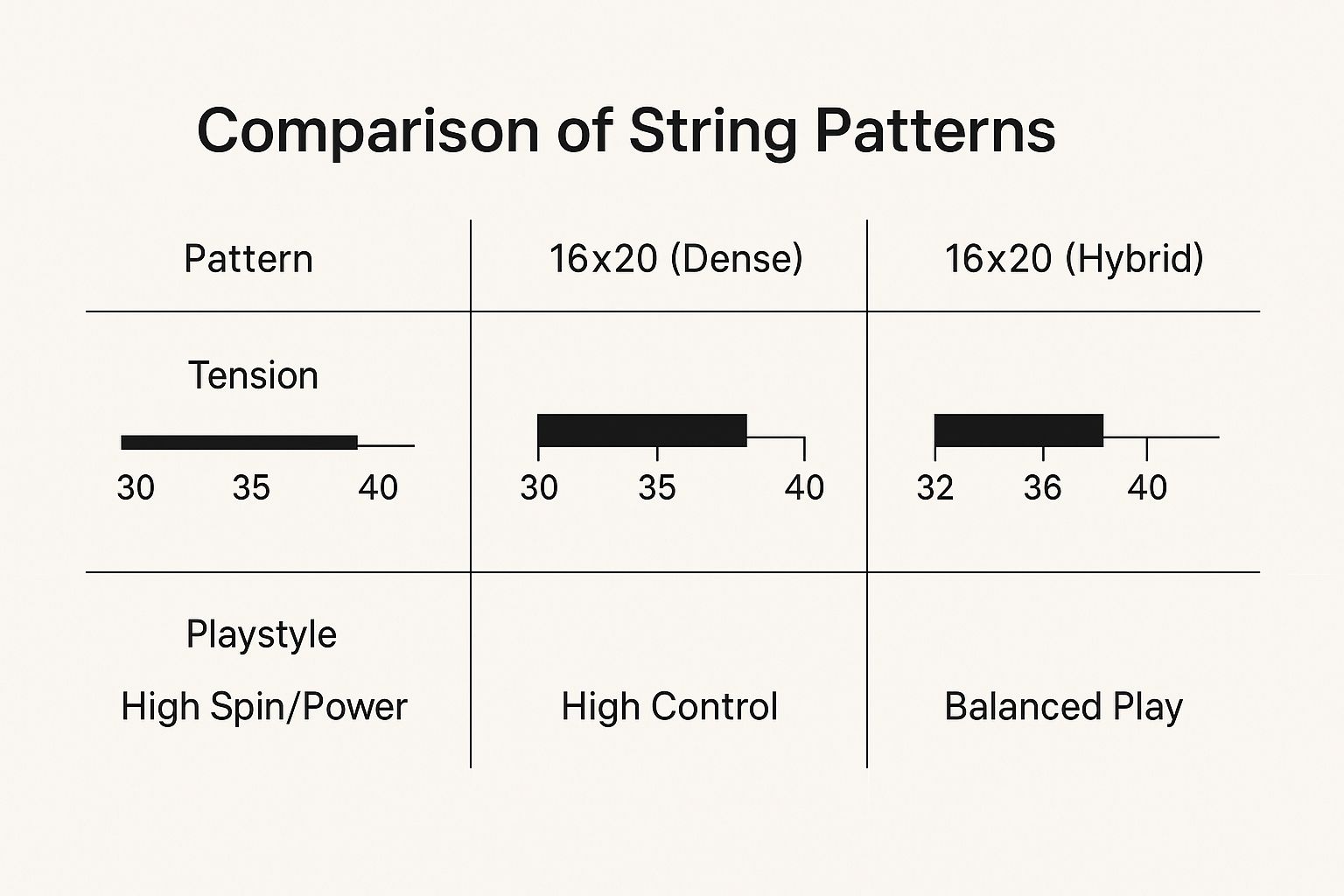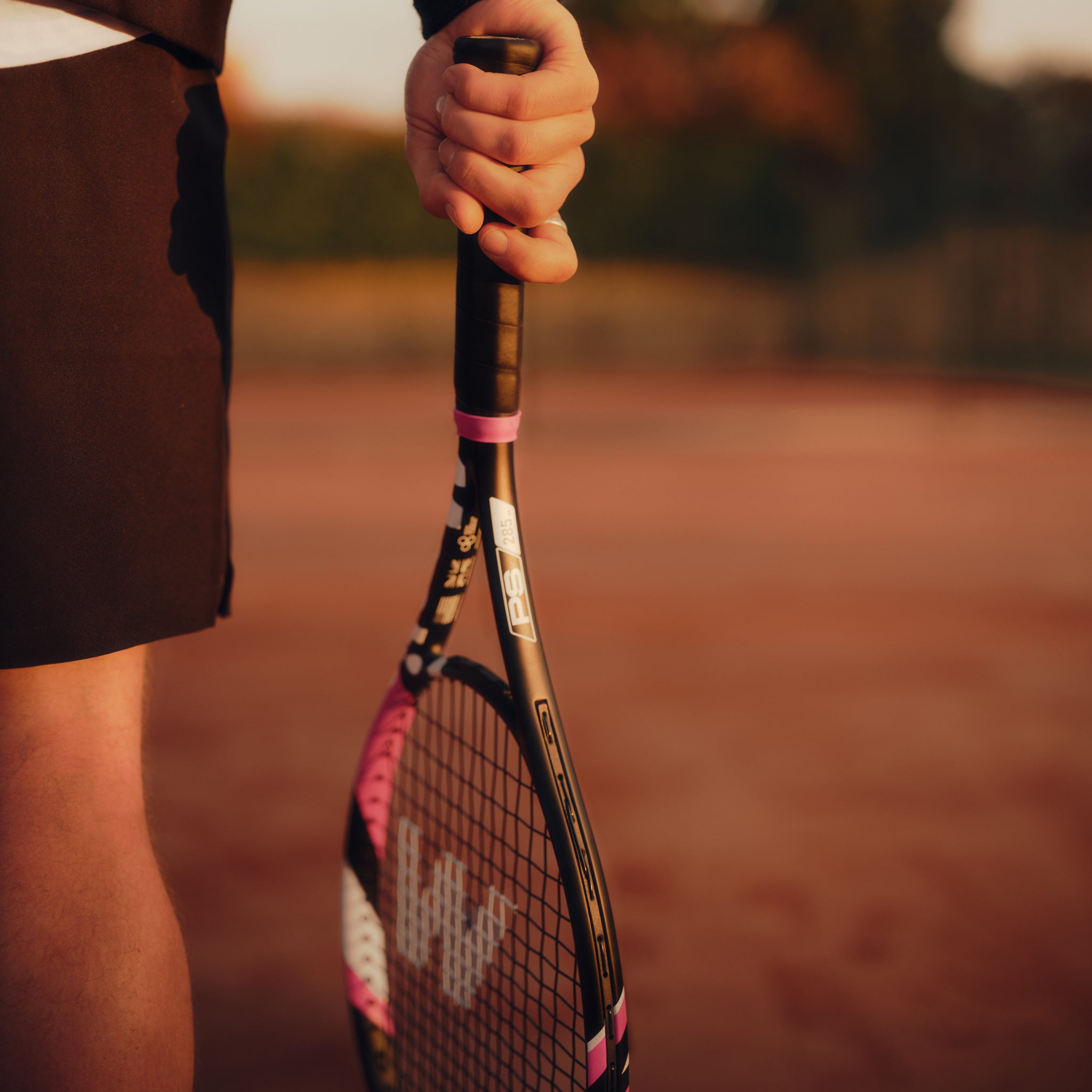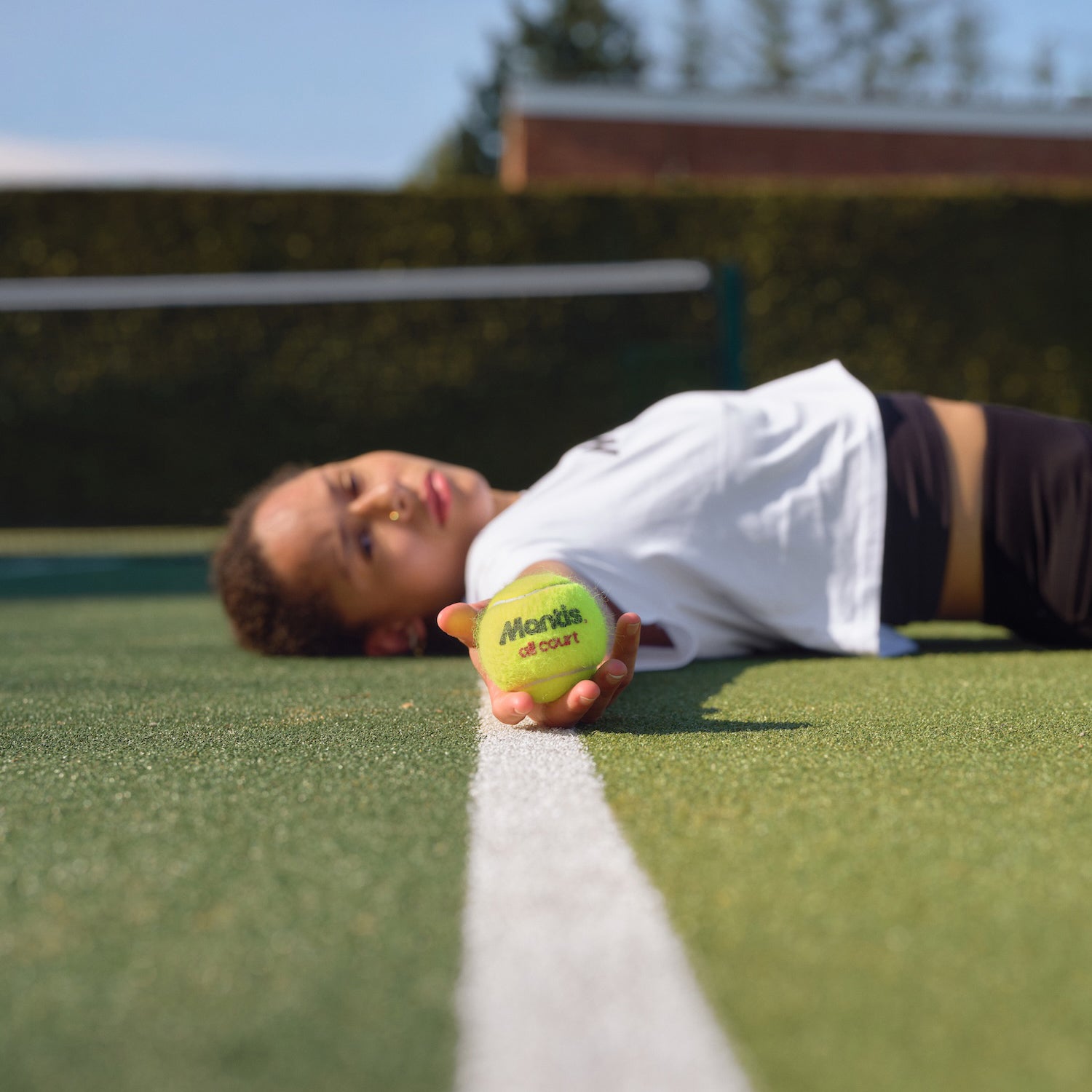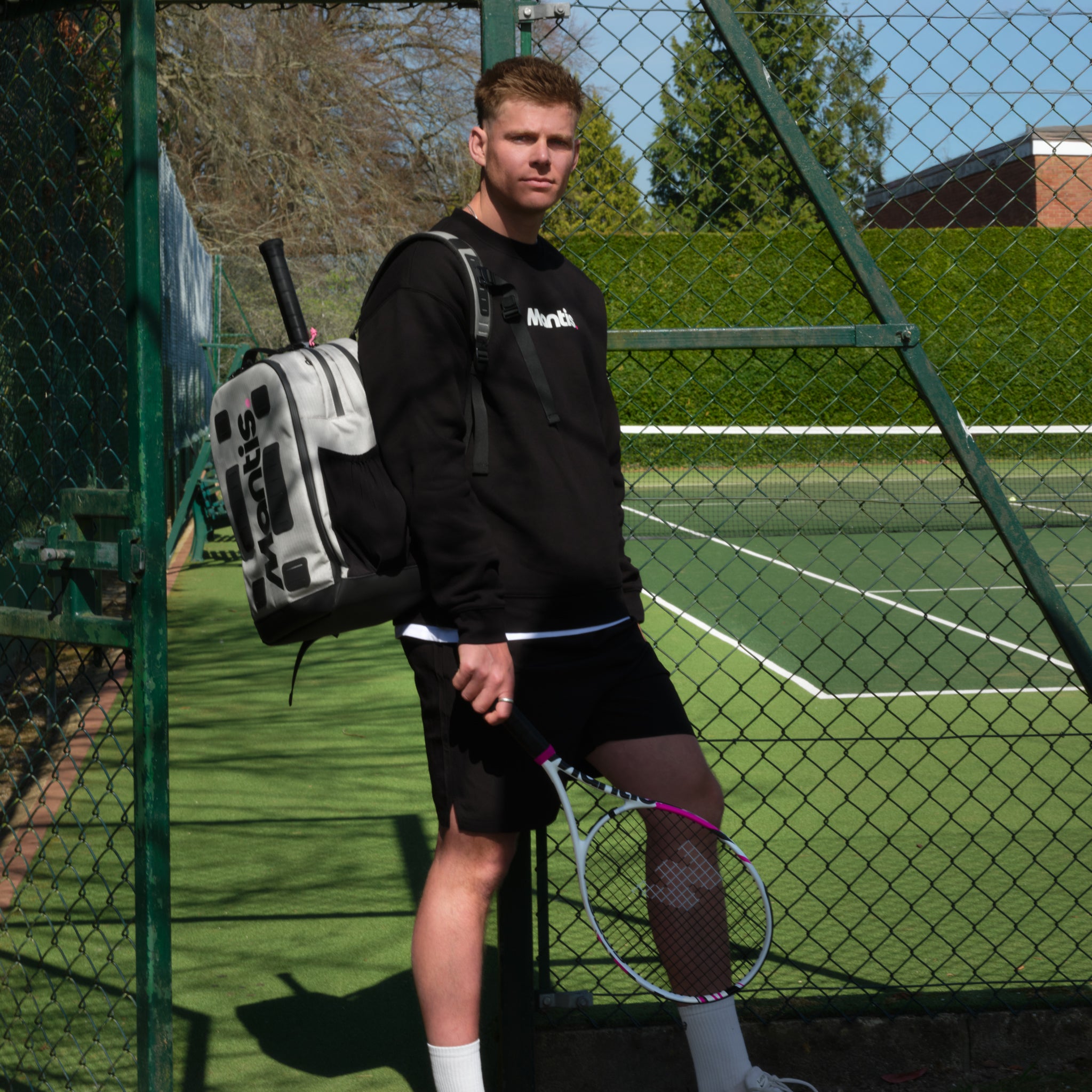
Compare tennis rackets is one of the biggest calls a player can make. At Mantis, we believe a great racket can genuinely elevate your game, but the selection process can feel overwhelming. This is why our guide on choosing a tennis racket is so valuable for players. Once you understand what makes a racket tick, you’re halfway to finding the perfect one for you.
This guide is designed to cut through the noise. We'll walk you through how to compare rackets by focusing on the things that actually matter on court: from the materials it’s made of and its weight, to its balance, head size, and string pattern.
This focus on equipment is a bigger deal than ever. The tennis equipment market here in the United Kingdom, for instance, was valued at roughly USD 150.45 million in 2024. That number is expected to climb to USD 227.12 million by 2035, a steady rise fuelled by new sports tech and clever innovations in racket design. You can discover more about the UK tennis equipment market growth and what's driving it.
The real goal here is to stop you from getting lost in marketing jargon. Instead, you'll learn to look at the specs like a pro, making a smart decision that lines up with your unique style of play. A great racket should feel less like a tool and more like a natural extension of your arm.
A Framework to Compare Tennis Rackets
So, how do you actually compare one racket to another? You need a simple framework. When you break down the specifications into clear categories, you can immediately see the link between a racket's design and how it will behave during a match.
It’s not about finding the "best" racket out there. It’s about finding the best racket for you. That means matching its characteristics to your body, your swing, and how you think on the court.
To get started, here’s a quick way to assess the key attributes of any racket you might be considering.
Quick Racket Comparison Framework
Use this framework to quickly assess the key attributes of any tennis racket and determine its suitability for your playing style.
| Racket Attribute | What It Influences | Ideal for Which Player Type |
|---|---|---|
| Weight & Balance | Stability, manoeuvrability, and power generation. | Lighter for beginners; heavier for advanced players. |
| Head Size | Sweet spot size, forgiveness, and control. | Larger for forgiveness; smaller for precision. |
| String Pattern | Spin potential and stringbed feel. | Open patterns for spin; dense patterns for control. |
| Material/Stiffness | Power, comfort, and feedback. | Flexible for comfort; stiff for power. |
Having a structured approach like this makes it much easier to size up any racket you pick up. Whether you’re a beginner just getting your strokes down or an experienced player looking for that extra edge, understanding these fundamentals is the key to choosing with confidence. We’ll dive deeper into each of these elements in the next sections.
Understanding Racket Materials and Construction
The stuff a racket is made of is, quite literally, the foundation of how it feels and performs on court. Here at Mantis, we live by the idea that how a racket is built directly translates to how it plays. To really get your head around comparing tennis rackets, you first have to understand what’s inside them. Our in-depth guide on understanding tennis racket specifications is a great place to start that journey.
Modern rackets are worlds away from the old wooden frames. Today's models are sophisticated tools, engineered from advanced composites where every single fibre is chosen to create a specific set of characteristics. This obsession with technology is a massive part of why the sport keeps getting more exciting.
The UK's role in this is pretty significant, too. Projections show that by 2025, the UK will make up around 13.32% of the entire European tennis racket market, which is valued at an estimated USD 143.56 million. This isn't just a number; it tells us that British players are technically savvy and demand equipment that delivers real performance.
The Evolution from Aluminium to Composites
Early metal rackets were mostly made from aluminium. It was a big step up from wood, offering more durability and power, but it came with its own problems—namely, it was heavy and could easily warp out of shape. You’ll still find it in some very basic, low-cost rackets, but for the most part, its time has passed.
The real game-changer was the arrival of graphite. It’s lightweight yet incredibly strong, which allowed manufacturers to build frames that were both powerful and stable without feeling like you were swinging a sledgehammer. To this day, it remains the core material in most performance rackets.
Modern Material Blends
But it's rarely just about one material anymore. At Mantis, we engineer our frames using very precise blends to fine-tune the playing experience down to the smallest detail.
- Carbon Fibre: Often mixed with graphite, carbon fibre makes a frame stiffer. A stiffer frame bends less when it hits the ball, meaning more energy is fired back for a more powerful shot.
- Basalt: This is volcanic rock, melted down and woven into fibres. When we integrate it into a racket's layup, basalt is brilliant at dampening vibrations. It soaks up the harsh, jarring frequencies but still lets you feel the ball on the strings.
- Tungsten: As a dense metal, tungsten is perfect for adding weight strategically. By placing tiny amounts of it in key spots—like at 3 and 9 o'clock on the racket head—we can boost stability on off-centre hits, which makes the sweet spot feel much bigger.
This 'cocktail' approach to materials gives us a level of customisation that was once unthinkable, allowing us to build rackets for every kind of player and every kind of game.
The key thing to remember is that material choice is a constant balancing act between power and comfort. Stiffer materials like graphite and carbon fibre give you more pop, while flexible or dampening ones like basalt make the ride smoother.
How Materials Impact Your Experience
Once you understand these materials, you can start to decode a racket’s spec sheet. A frame with a high percentage of graphite and carbon fibre will feel crisp, direct, and powerful. It’s perfect for an advanced player who creates their own pace and wants unfiltered feedback from the ball.
On the other hand, a racket that weaves in basalt or other dampening tech will have a more muted, comfortable feel. This is ideal for a beginner or intermediate player who needs a more forgiving response and wants to protect their arm from nasty vibrations. This careful, deliberate selection of materials is right at the heart of how we design every Mantis racket.
Analysing Weight and Balance for the Optimal Feel
Forget the fancy materials for a moment. When it comes to how a racket actually feels and performs in your hand, its weight and balance point are king. Here at Mantis, we don't just assemble rackets; we meticulously engineer these interconnected attributes to fit specific types of players. Our complete Mantis Performance Tennis Racket range is a perfect showcase of these principles in action across various models.
The relationship between weight and balance is a delicate dance. It directly dictates your swing speed, how stable the racket feels on impact, and ultimately, how much power you can generate. It’s not a simple case of heavy versus light; it's all about where that mass is distributed along the frame.
Static Weight Versus Swingweight
First, let's clear up two key terms. Static weight is just what it sounds like: how much the racket weighs on a set of scales, typically measured in grams. It's a useful starting point, but it only tells you half the story.
Swingweight, on the other hand, is a measure of how heavy the racket feels when you swing it. This is influenced by both the total weight and how that weight is spread out. You could have two rackets with the exact same static weight, but they can feel worlds apart in motion because of different swingweights.
A higher swingweight generally gives you more stability and power—the racket feels like it can plough through the ball. A lower swingweight makes the racket feel more nimble and easier to swing fast, which is brilliant for quick-fire volleys at the net or whipping up racket head speed.
The Three Balance Categories
A racket’s balance is simply where its centre of mass is located. This gives us three main categories, each with its own distinct personality on the court.
-
Head-Heavy (HH): More weight is loaded into the head of the racket. This setup helps generate easy power, making it a solid choice for beginners or players with shorter, compact swings who need the frame to do more of the work.
-
Head-Light (HL): More weight is packed into the handle area. This makes the racket feel much quicker and more manoeuvrable. It’s the go-to for advanced players who create their own power with long, fast swings and need lightning-fast reactions for net play.
-
Evenly Balanced (EB): Just as it says on the tin, the weight is distributed uniformly. These rackets offer a blend of both worlds, striking a great compromise between power and handling. They're incredibly popular with a huge range of intermediate and all-court players.
Real-World Application and Trade-Offs
So, which is right for you? That choice comes down entirely to your physical strength and swing mechanics. It's a classic game of trade-offs, and understanding them is crucial when you compare tennis rackets.
| Balance Type | Primary Advantage | Ideal Player Scenario | Key Trade-Off |
|---|---|---|---|
| Head-Heavy | Easy Power & Stability | A developing player stuck on the baseline, needing a bit of help to get depth on their shots. | Can feel sluggish and is less manoeuvrable at the net. |
| Head-Light | Manoeuvrability & Control | An aggressive all-courter who needs to react instantly for volleys and generate serious racket head speed on serves. | Less forgiving on off-centre hits; requires the player to supply their own power. |
| Evenly Balanced | Versatility & Blend | An intermediate player who mixes baseline rallies with net approaches and needs a racket that can do a bit of everything. | Doesn't truly excel in one specific area. It's a jack-of-all-trades, master of none. |
One of the biggest misconceptions is that a heavier racket is always harder to swing. In reality, a heavy but significantly head-light racket can feel quicker through the air than a lighter but head-heavy one. This is exactly why you have to look beyond the static weight on the spec sheet. Considering the balance point—and by extension, the swingweight—is what will lead you to a frame that genuinely complements your game.
The Role of Head Size and String Pattern
Now let’s move beyond the fancy materials and weight distribution. The real heart of how a racket plays comes down to its head size and string pattern. The Mantis lineup is designed with a whole range of combinations because we know every player has a different game plan.
These two specs are where you start to see a racket’s personality emerge. They dictate how forgiving it is when you don’t hit the ball dead-centre, how much free power you get, and how much wicked spin you can put on your shots.
It’s clear players are getting savvier about their gear. In the UK, the tennis market is seeing a steady annual growth of around 1.3%, and it’s on track to top 1.2 million rackets sold each year. This isn't just about more people playing; it's about players actively hunting for equipment that gives them an edge.
Decoding Head Size Categories
When we talk about head size, we’re just talking about the surface area of the strings, measured in square inches. It’s the single biggest factor in determining the size of the sweet spot—that magical area where the ball feels like it just explodes off the strings.
Generally, you’ll find rackets fall into one of three camps:
-
Oversize (105 sq. in. and above): These are the most generous rackets you can buy. They offer a massive sweet spot, which means even your off-centre shots will have a decent bit of oomph. They also generate a ton of power because the larger stringbed acts like a trampoline. Perfect for beginners who need a helping hand with power and finding the middle of the racket.
-
Mid-plus (98-104 sq. in.): Welcome to the sweet spot of the market itself. This is the most popular category for a reason—it’s the jack-of-all-trades. A mid-plus head is forgiving enough for intermediates but offers the precision that advanced players demand. It’s a brilliant all-rounder.
-
Midsize (97 sq. in. and below): These are the player’s frames. With the smallest head sizes, they demand impeccable timing and technique. The payoff? Unmatched control and a connected feel that lets you place the ball on a sixpence. You’ll almost exclusively see advanced and pro players using these.
The trade-off with head size is beautifully simple. Go bigger for more power and a larger sweet spot, but you sacrifice some control. Go smaller for surgical precision, but you’d better be confident in your ability to strike the ball cleanly.
The Impact of String Patterns
Next up is the string pattern—the grid of main (vertical) and cross (horizontal) strings. How dense or open this grid is completely changes the feel of the racket, especially when it comes to spin and control.
An open string pattern (like 16x19) means there are fewer strings and bigger gaps between them. When you hit the ball, the strings can move more freely, bite into the felt, and then snap back into place. That ‘snapback’ is what generates massive topspin, letting you hit heavy, dipping shots that drive your opponents crazy.
On the other hand, a dense string pattern (like 18x20) packs more strings into the same space. This creates a much firmer, more controlled stringbed. The strings don’t move as much on impact, giving you a predictable, low-launching response. This is the pattern for players who flatten out their shots and live and die by their accuracy.
Putting It All Together for Your Game
The real magic happens when you understand how head size and string pattern work together to complement different playing styles.
| Player Style | Recommended Head Size | Recommended String Pattern | Why It Works |
|---|---|---|---|
| Baseline Grinder | Mid-plus (100 sq. in.) | Open (16x19) | The generous 100 sq. in. head offers a good margin for error during long, gruelling rallies. The 16x19 pattern provides the heavy topspin needed to push opponents back and keep the ball dipping inside the baseline. |
| All-Court Player | Mid-plus (98 sq. in.) | Dense (18x20) | A slightly smaller 98 sq. in. head gives you the confidence to attack from anywhere. The dense 18x20 pattern delivers the pinpoint control needed for crisp volleys, sharp slices, and finding the corners. |
| Aggressive Beginner | Oversize (107 sq. in.) | Open (16x18) | The huge head size provides easy power and an enormous sweet spot, making tennis fun and forgiving. An open pattern helps add natural spin to developing shots, encouraging good technique from the start. |
Ultimately, finding the right racket is about honesty. Are you a baseline warrior who lives on heavy topspin, or a serve-and-volley artist who needs surgical precision? Your on-court identity should be the compass that guides your choice of head size and string pattern.
Matching Racket Specs to Player Profiles
Now that we've broken down the technical side of things, we can get to the fun part: matching rackets to real-world players. At Mantis, our philosophy is simple – we want to get the right equipment into your hands for whatever stage of the tennis journey you’re on. Our guide on choosing a tennis racket is a great place to start, but when you compare tennis rackets, remember that context is everything. A frame that feels like an extension of a pro's arm could feel like a plank of wood to a club player.
We’ll look at three main groups: beginners just finding their feet, intermediate players honing their game, and advanced competitors who live and die by precision. By mapping out the ideal racket specs for each, we can turn those abstract numbers into real, tangible advantages on the court. It's about moving beyond a simple list of features to find the frame that truly fits your game.
The Beginner Profile
If you're just starting out, the name of the game is consistency and comfort. You need a racket that works with you, not against you, making it as easy as possible to learn the fundamentals and, most importantly, have fun.
The perfect beginner's racket is usually light, somewhere between 255 and 285 grams. This makes it easy to swing without tiring out your arm, letting you focus on developing smooth, correct technique. A head-heavy balance is another great feature for newcomers, as it helps generate a bit of extra pop behind the ball, even on shorter, less powerful swings.
And finally, a generous head size of 102 square inches or more is your best friend. It creates a much larger sweet spot, which means more forgiveness when you don't strike the ball perfectly in the centre. This forgiveness builds confidence and helps you get the ball over the net consistently.
The Intermediate Player Profile
Intermediate players are past the initial learning curve. You can hold your own in a rally, you're starting to develop favourite shots, and a distinct playing style is beginning to emerge. Your racket needs to be a versatile partner that can support this growth.
For this group, rackets in the 285 to 310-gram weight range are often the sweet spot. They offer more stability to handle pace from your opponents but are still manoeuvrable enough for quick reactions at the net. You’ll typically see evenly balanced or slightly head-light frames here, providing a fantastic blend of power and control that suits an all-court game.
A key consideration for intermediate players is the racket's ability to offer feedback. It should be comfortable but not so muted that it hides technical flaws. This is the stage where a racket must reward good shots and communicate what went wrong on poor ones.
The Advanced Competitor Profile
Advanced players don't need the racket to create power for them—they bring their own. Their game is built on precision, strategy, and staying solid under pressure. They need a racket that feels less like a tool and more like a surgical instrument, offering maximum control and feel.
These rackets are almost always heavier, weighing in at over 310 grams. That extra mass provides rock-solid stability, allowing players to absorb and redirect heavy shots without the frame twisting in their hand. To keep the racket from feeling sluggish, a head-light balance is essential, ensuring it remains quick and easy to manoeuvre for sharp volleys and last-second adjustments.
You'll also find smaller head sizes, usually 98 square inches or less, which deliver the pinpoint accuracy required to hit small targets time and time again. For these players, details like string patterns become critical for fine-tuning spin, control, and overall response.
This infographic shows just how much string patterns and tensions can be tailored to suit a specific playstyle.

As you can see, there’s a clear trade-off: open patterns for more spin versus dense patterns for greater control. For an advanced player, getting this detail right is a vital piece of the puzzle.
To bring it all together, here’s a quick-reference table to help guide your decision based on your current level.
Racket Recommendations by Player Profile
| Player Profile | Recommended Weight | Recommended Balance | Recommended Head Size | Key Benefit |
|---|---|---|---|---|
| Beginner | 255g - 285g | Head-Heavy | 102 sq. in. + | Forgiveness and easy power generation |
| Intermediate | 285g - 310g | Even or Head-Light | 98-102 sq. in. | A versatile blend of power and control |
| Advanced | 310g + | Head-Light | 98 sq. in. or less | Maximum control, stability, and feel |
This table serves as a strong starting point, but remember that feel is personal. Use these guidelines to narrow your choices, but always try to demo a racket if you can before making a final decision. Your game will thank you for it.
Making a Confident Racket Choice
We've covered a lot of ground on the technical side of things, but the final step happens where it matters most: on the court. Think of this guide, and our other resources like how to choose a tennis racket, as your companion on your tennis journey. At Mantis, our whole philosophy is about empowering players with understanding, not just selling them equipment. The goal is to help you trust your own instincts, backed by a solid grasp of how a racket really works.
The Key Trade-Offs Summarised
Let's be clear: there’s no single racket that does everything perfectly. Choosing one is all about prioritising what you need most for your game. It always comes down to balancing a few key characteristics.
-
Power vs Control: This is the age-old dilemma in racket design. As a rule, frames that give you more pop (stiffer, with larger heads) tend to sacrifice a bit of control. On the flip side, frames that offer sublime control (more flexible, with smaller heads) will ask you to bring your own power to the party. You need to be honest with yourself about which end of that spectrum you need more help with.
-
Manoeuvrability vs Stability: A lighter, head-light racket feels lightning-fast and is a dream to handle, especially for quick exchanges at the net. But a heavier frame with more mass behind the ball will feel much more stable, refusing to twist in your hand when you're absorbing or redirecting a heavy-hit ball. An all-court player might lean towards manoeuvrability, while a hard-hitting baseliner will crave that stability.
Don't think of these as weaknesses in a racket’s design. They’re deliberate choices. Your job is to find the racket whose compromises you barely notice, but whose strengths feel like they were made just for you.
Your racket should complement your strengths and shore up your weaknesses. Forget about choosing a frame based on what your favourite pro uses; pick the one that your game is asking for right now.
The Importance of the On-Court Demo
Reading specs and reviews is a fantastic way to build a shortlist. But nothing, and we mean nothing, replaces the feel of a racket in your hand as it connects with a tennis ball. We can’t stress this enough: always try to demo a racket before you buy it.
A frame that looks perfect on paper can feel completely alien on the court. When you demo, don’t just have a casual hit. Go in with a plan and put the racket through its paces.
Your On-Court Evaluation Checklist
When you take a demo racket for a spin, be methodical. Test it across every part of your game and pay close attention to how it performs during these key shots:
- Groundstrokes: Are you getting easy depth on your shots? Do you feel connected to the ball, giving you the confidence to aim for smaller targets?
- Serves: Does the frame help you whip the racket head through for more power, or does it give you the pinpoint precision to hit your spots?
- Volleys: Does it feel quick and easy to get into position, or is it solid and stable when you need to block back a powerful passing shot?
- Off-Centre Hits: How forgiving is it? When you don't catch the ball perfectly in the centre, does the racket still feel stable and deliver a decent shot?
Ultimately, you’re looking for a racket that feels like a partner in your development as a player. With the knowledge you’ve gained, you can trust your gut. The right racket is the one that gives you the confidence to walk on court and play your best tennis.
Your Racket Questions, Answered
Even with all the specs laid out, choosing a new racket always brings up a few final, nagging questions. We get it. At Mantis, we've heard just about every query imaginable from players trying to dial in their gear. Hopefully, our answers to the most common ones we hear, based on years of experience, help you find the perfect partner for your game from our full range of Mantis rackets.
How Often Should I Replace My Tennis Racket?
There’s no strict "use by" date, but for most regular club players, the sweet spot for a replacement is around every 2-3 years. It’s not a sudden failure; think of it more like a slow, gradual fade.
After thousands of hits, the composite materials in the frame start to lose their pop and resilience. You'll begin to feel it. Shots might not fly off the strings with the same authority, the frame could feel a bit hollow or jarring on off-centre hits, or you might notice new vibrations creeping up your arm. That's the frame telling you its structural integrity is starting to wear down, which affects both performance and your comfort.
What’s More Important: Weight or Balance?
This is the classic chicken-or-egg question of racket specs. The honest answer? Neither is more important. They are two sides of the same coin, working in tandem to create the racket's personality. What you're really feeling is their combined effect, a metric we call swingweight.
A heavy racket that's significantly head-light can feel surprisingly fast and easy to swing, much more so than a lighter frame that's head-heavy. The first gives you stability from its sheer mass, while the second uses leverage to help generate pace.
The real question isn't about which spec is better, but about which combination of weight and balance best complements your personal swing mechanics and playing style. A high swingweight offers more plough-through, while a lower swingweight provides easier acceleration.
Does the String Pattern Really Affect Spin?
Yes, absolutely. It's one of the biggest factors in a racket's spin potential, right up there with swing path and string type.
An open string pattern, like a 16x19, is built for spin. The wider gaps between the strings allow them to bite into the ball more effectively. On impact, the main strings can move apart, grip the felt, and then violently snap back into place, launching the ball with heavy rotation.
On the other hand, a dense string pattern like an 18x20 puts control first. The strings are packed tighter, so they don't move as much at contact. This creates a firmer, more connected feel and a lower, more direct ball flight. It's the go-to choice for players who flatten out their shots and demand pinpoint precision. Your choice here should be a direct reflection of whether your game is built on heavy topspin or laser-like accuracy.
At Mantis, we engineer equipment with a single-minded focus on performance. We obsess over the details so you can focus on your game. Discover the Mantis difference and find the racket built for your ambition.








